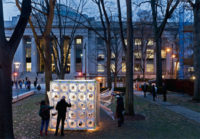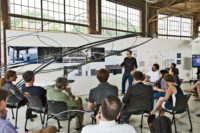The last time anyone made a fuss over the architecture of the New York Times’ headquarters was in the first decade of the 20th century. Then Cyrus Eidlitz, with Andrew C. MacKenzie, designed the Times’ offices, completed in 1905, for a new location far removed from its old home amid a cluster of newspaper buildings down by City Hall.

In an essay in RECORD, in 1903, Montgomery Schuyler, a staff member of the Times from 1883 to 1907 and a frequent contributor to RECORD, lauded the new Italian Renaissance-style tower going up on Longacre Square, at the crossroads of 42nd Street, Broadway, and Seventh Avenue. Indeed, the trapezoidal site presented an opportunity for a skyscraper to be seen in the round from many vantage points, unlike so many other high-rises embedded in the blocks of New York City’s grid. Because of its island-like site and its 363-foot-height for the 25-story building, Eidlitz conceived it as a campanile on a base, eschewing the oft-favored typologies of the mansard- roofed chateau or a rectangular tower. When it was built, the Times tower was the second tallest building in Manhattan (next to R.H. Robertson’s 391-foot-high Park Row Building of 1899).
Eidlitz and MacKenzie kept a tripartite division (base, shaft and crown) common to skyscraper treatments, placing the tower at the broad end of the site. Schuyler commended this “campanile of Giotto” for the manner in which a four-story glazed opening, united by piers and pilasters, expressed the placement of the news room and publisher’s offices on the seventeenth through the twentieth floors. A three-story arcade between the thirteenth and fifteenth floors indicated the business and circulation offices, while the composing room on the sixteenth floor was treated on the façade as a transitional space.
Schuyler considered such programmatic clarity, that is, the expression of the function on the exterior, as appropriately modern, even if the actual style looked back to the Renaissance for its motifs. Schuyler also approved its verticality as well, for it “suggested a Gothic treatment and gave the work more the aspect of a cathedral.” Nevertheless the critic found fault with Eidlitz for not “treating this edifice as a frame building,” but making the steel structure look as if it were self-supporting masonry.
While Schuyler’s relationship with Eidlitz’s father, Leopold—an architect and theorist with a great influence on the critic—and his employment by the Times would seem to guarantee a favorable review (as well as a conflict of interest), Schuyler’s critique nevertheless provides a glimpse into the symbolic significance of this solution. Schuyler was pointing out the need to design ever taller buildings as three-dimensional objects with four sides.
Unfortunately New York Times outgrew the campanile and had to expand to larger quarters on 43rd Street in 1913. The 1905 tower, whose completion had spurred a change of the name for the location from Longacre Square to Times Square, was the reason for another tradition: The Times celebrated its new headquarters in New Year’s Eve of 1907, by dropping a ball of incandescent lights from its top at the stroke of midnight. The event became an annual tradition, halted only during World War II.
Long after the Times had left the building, the tower was “modernized” in 1966 by architects Smith, Smith, Haines, Lundberg, and Whaeler. It lost its neo-Renaissance trappings. Now 1 Times Square, as it is known, is swathed in billboards in accordance with zoning provisions passed in 1987. A magnificent architectural presence has disappeared from this very visible site.
Originally published in our February 2008 issue.



Post a comment to this article
Report Abusive Comment